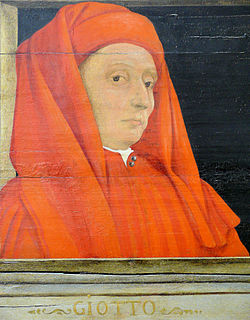
Back Giotto di Bondone AN جوتو دي بوندوني Arabic جوتو دى بوندونى ARZ Giotto AST Cotto Azerbaijani Джотто ди Бондоне Bashkir Джота дзі Бандонэ Byelorussian Джота BE-X-OLD Джото Bulgarian Giotto Bislama
Giotto di Bondone | |
|---|---|
 Posthumous portrait of Giotto, made between 1490 and 1550 | |
| Born | Giotto di Bondone c. 1267 |
| Died | January 8, 1337 (aged 69–70) Florence, Republic of Florence |
| Nationality | Italian |
| Known for | Painting, fresco, architecture |
| Notable work | Scrovegni Chapel frescoes, Campanile |
| Movement | |
Giotto di Bondone (Italian pronunciation: [ˈdʒɔtto di bonˈdoːne]; c. 1267[a] – January 8, 1337),[2][3] known mononymously as Giotto (UK: /ˈdʒɒtoʊ/ JOT-oh,[4] US: /dʒiˈɒtoʊ, ˈdʒɔːtoʊ/ jee-OT-oh, JAW-toh)[5][6] and Latinised as Giottus, was an Italian painter and architect from Florence during the Late Middle Ages. He worked during the Gothic and Proto-Renaissance period.[7] Giotto's contemporary, the banker and chronicler Giovanni Villani, wrote that Giotto was "the most sovereign master of painting in his time, who drew all his figures and their postures according to nature" and of his publicly recognized "talent and excellence".[8] Giorgio Vasari described Giotto as making a decisive break from the prevalent Byzantine style and as initiating "the great art of painting as we know it today, introducing the technique of drawing accurately from life, which had been neglected for more than two hundred years".[9]
Giotto's masterwork is the decoration of the Scrovegni Chapel, in Padua, also known as the Arena Chapel, which was completed around 1305. The fresco cycle depicts the Life of the Virgin and the Life of Christ. It is regarded as one of the supreme masterpieces of the Early Renaissance.[10]
The fact that Giotto painted the Arena Chapel and that he was chosen by the Commune of Florence in 1334 to design the new campanile (bell tower) of the Florence Cathedral are among the few certainties about his life. Almost every other aspect of it is subject to controversy: his birth date, his birthplace, his appearance, his apprenticeship, the order in which he created his works, whether he painted the famous frescoes in the Upper Basilica of Saint Francis in Assisi, and his burial place.
- ^ Cite error: The named reference
Sarelwas invoked but never defined (see the help page). - ^ "Giotto's date of birth differs widely in the sources, but modern art historians consider 1267 to be the most plausible, although the years up to 1275 cannot be entirely discounted." Wolf, Norbert (2006). Giotto di Bondone, 1267–1337: The Renewal of Painting. Hong Kong: Taschen. p. 92. ISBN 978-3822851609
- ^ Giotto at the Encyclopædia Britannica
- ^ "Giotto". Collins English Dictionary. HarperCollins. Retrieved June 1, 2019.
- ^ "Giotto" (US) and "Giotto". Lexico UK English Dictionary. Oxford University Press. Archived from the original on 2020-03-03.
- ^ "Giotto". Merriam-Webster.com Dictionary. Retrieved June 1, 2019.
- ^ Hodge, Susie (2016). Art in Detail: 100 Masterpieces. New York: Thames & Hudson. p. 10. ISBN 978-0-500-23954-4.
He worked during the period described as Gothic or Pre-Renaissance ...
- ^ Bartlett, Kenneth R. (1992). The Civilization of the Italian Renaissance. Toronto: D.C. Heath and Company. ISBN 0-669-20900-7 (Paperback). p. 37.
- ^ Giorgio Vasari, Lives of the Artists, trans. George Bull, Penguin Classics (1965), pp. 15–36.
- ^ Hartt, Frederick (1989). Art: a history of painting, sculpture, architecture. Harry N. Abrams. pp. 503–506.
Cite error: There are <ref group=lower-alpha> tags or {{efn}} templates on this page, but the references will not show without a {{reflist|group=lower-alpha}} template or {{notelist}} template (see the help page).
© MMXXIII Rich X Search. We shall prevail. All rights reserved. Rich X Search